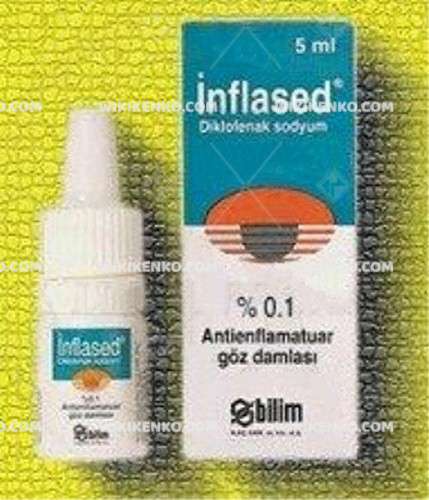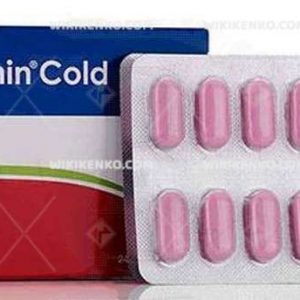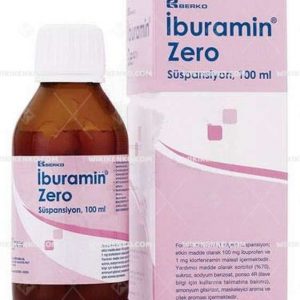Inflased Eye Drop
Unraveling the mysteries of Inflased Eye Drops, a potent ocular medication enriched with Diclofenac Sodium. Delve into its applications, potential side effects, onset of action, and crucial considerations.
| Dosage form | |
|---|---|
| Pack size | |
| Potency | %0.1 5Ml |
| Manufacturer | |
| Origin | |
| Generic Name (Ingredient) | Diclofenac Sodium 1 Mg / Ml |
Assuming your emergency circumstances for this product, visit Urgent Quotation page. Besides, for any pharmaceutical questions, please ask us in the comments section.
Description
Inflased Eye Drops, a pharmaceutical gem, finds its origins in Turkey. This ocular elixir bears the active ingredient Diclofenac Sodium, poised to address various ophthalmological conditions. While comprehensive information about this specific medication remains elusive, we unveil the power of Diclofenac Sodium, a renowned nonsteroidal anti-inflammatory drug (NSAID), instrumental in alleviating pain, quelling swelling, and taming inflammation.
Diclofenac Sodium
Understanding Diclofenac Sodium: Diclofenac Sodium, a stalwart in the realm of NSAIDs, is the foundational component of Inflased Eye Drops. Its primary mission is to combat pain, inflammation, and swelling. A versatile ally, it can be harnessed in various forms, each tailored to specific needs.
Diclofenac Sodium Side Effects
Common Occurrences
Diclofenac Sodium, like any pharmacological intervention, possesses its share of potential side effects. Frequently encountered discomforts may encompass indigestion, bloating, nausea, vomiting, and stomach pain.
Proceed with Caution
Venturing into the realm of Diclofenac Sodium entails a degree of vigilance. In rare instances, this NSAID may trigger severe side effects such as heart disease, stroke, kidney complications, and stomach ulceration. It’s pivotal to acknowledge that NSAIDs, including Diclofenac Sodium, can elevate the risk of grave cardiovascular thrombotic events, such as myocardial infarction and stroke. These perils may manifest early in treatment, with the likelihood amplifying with prolonged use. Notably, Diclofenac Sodium is contraindicated in the context of coronary artery bypass graft surgery.
NSAIDs, including Diclofenac Sodium, carry an elevated risk of significant gastrointestinal (GI) adverse events, inclusive of bleeding, ulceration, and intestinal perforation. These perils may manifest at any point during use, sans warning symptoms. Elderly patients and individuals with a history of peptic ulcer disease and/or GI bleeding are especially vulnerable.
Onset of Action
The swiftness with which Diclofenac Sodium springs into action hinges on its form of administration. When applied in the form of a gel, the onset of relief may take up to four hours. In contrast, non-gel forms like tablets or capsules can unleash their therapeutic prowess within a mere 30 minutes. However, it’s paramount to appreciate that the timeline of efficacy can exhibit considerable variability among individuals. Factors such as the severity of the targeted condition and variances in metabolic rates contribute to this diversity.
Missed a Dose? Handle It Right
If the memory of a missed dose of Diclofenac Sodium comes knocking, prompt action is advised. Administer the missed dose as soon as it dances into your awareness. Nevertheless, if your next scheduled dose looms closely on the horizon, consider discretion and skip the missed one. Refrain from compensating with extra medication; adherence to the recommended dosing schedule, as guided by your healthcare provider or the medication label, is paramount.
Alcohol and Diclofenac Sodium
A Contraindicated Pair: The coupling of alcohol and Diclofenac Sodium is not advised. This unholy alliance heightens the risk of gastrointestinal bleeding and stomach ulcers. The consumption of alcohol can irritate the stomach lining, and when blended with Diclofenac Sodium, the propensity for side effects escalates. The peril is particularly pronounced for those who embark on prolonged NSAID therapy or indulge in copious alcohol consumption. Healthcare professionals resolutely counsel against this risky convergence to avert potential complications and adverse effects.
Conclusion
In conclusion, Inflased Eye Drops, enriched with Diclofenac Sodium, emerges as a formidable contender in the arena of ophthalmological care. While this article offers insights into the medication, it is imperative to remember that personalized medical guidance is paramount. Always consult with a healthcare professional to navigate the nuances of medication and safeguard your well-being
Use the form below to report an error
Please answer the questions as thoroughly and accurately as possible. Your answers will help us better understand what kind of mistakes happen, why and where they happen, and in the end the purpose is to build a better archive to guide researchers and professionals around the world.
The information on this page is not intended to be a substitute for professional medical advice, diagnosis, or treatment. always seek the advice for your physician or another qualified health provider with any questions you may have regarding a medical condition. Always remember to
- Ask your own doctor for medical advice.
- Names, brands, and dosage may differ between countries.
- When not feeling well, or experiencing side effects always contact your own doctor.
Cyberchondria
The truth is that when we’re sick, or worried about getting sick, the internet won’t help.
According to Wikipedia, cyberchondria is a mental disorder consisting in the desire to independently make a diagnosis based on the symptoms of diseases described on Internet sites.
Why you can't look for symptoms on the Internet
If diagnoses could be made simply from a textbook or an article on a website, we would all be doctors and treat ourselves. Nothing can replace the experience and knowledge of specially trained people. As in any field, in medicine there are unscrupulous specialists, differences of opinion, inaccurate diagnoses and incorrect test results.





Reviews
There are no reviews yet.